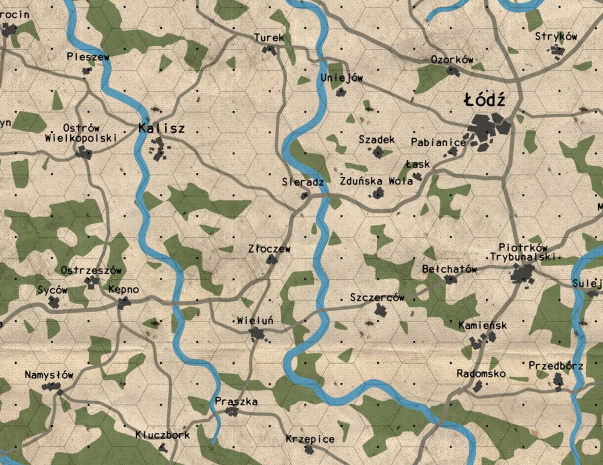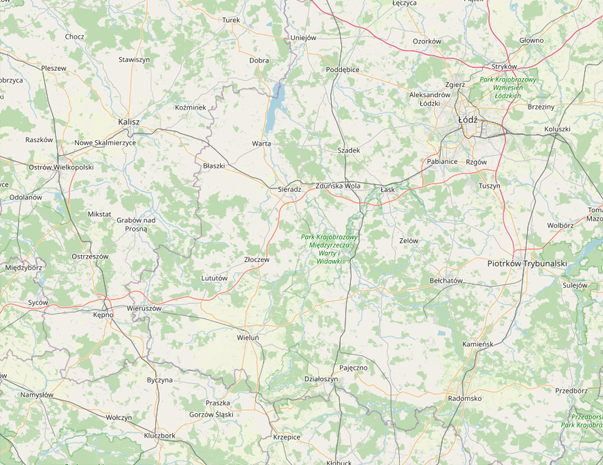In the last post we reviewed some basic real-world data for soldiers marching from one hellscape to another. Now we can start identifying problems with how this is represented in-game in Twilight, and then how to fix it.
Show Me What You’re Workin’ With
Twilight: 2000 4th Edition breaks down time into “shifts” of about 6 hours. So, you’ve got 4 shifts in a day, and during those shifts you can do things like march, hunt, scrounge, etc. That’s fine. I do have a few practical problems with it after running it for a while, and noticing that all of our worst sessions are ones that involve actually tracking shifts at all… but for now I digress. The game also provides nice, visually pleasing hex maps of most of Poland (and Sweden), with each hex 10km in scale.
Under good circumstances, you can march two hexes per shift on a road or in open terrain. Off-road or in any terrain type except open, you can march one hex per shift.
On a road, we can march 2 hexes per shift. That’s 20km. 20km divided by the 6 hours in a shift is a little more than 3kph. If we assume that we are taking reasonable rest halts, and probably not actually marching for at least an hour of that six hours, that math works out pretty close to what the DoD tells us. What else do the rules say? Off-road, we make half that speed, or about 1.7 kph. That’s admirably close to our real-world numbers, so I can’t fault anyone here so far!
The rules allow us to march up to two shifts per day without issue. So that’s 40km. Now, it’s 40km on a hex-map. That is, straight lines that are as efficient as hexes can possibly be. In the real-world, that road you’re marching on might take some significant detours along its route, but there’s just not fidelity here to manage it.
Already we’re bumping into a problem that I have found recurring over and over through this system: 10km is just an awfully big space. Bumping the scale to 5km hexes would immediately resolve a lot of wackiness that follows. Several times now I’ve come thiiiiiis close to making that 5km map to just be done with it. But that’s a huge PITA, so I haven’t. But I might! Or I might not. The tension.
 This is a pleasantly designed map, except that it also omits a ton of pretty relevant detail
This is a pleasantly designed map, except that it also omits a ton of pretty relevant detail
 and this is what the same area really looks like with the abstraction removed. Not even visible here is the fact that roughly every single kilometer of this area you will find some farmstead or village or industrial plant or all of the above!
and this is what the same area really looks like with the abstraction removed. Not even visible here is the fact that roughly every single kilometer of this area you will find some farmstead or village or industrial plant or all of the above!
… obviously some abstraction is needed in gaming. But I fear this map teaches a lot of very incorrect ground-level truths about the nature of the area that we are supposed to be vividly describing! I certainly was shocked as I learned a lot of this myself.
Anyway. We can march for two shifts and the game says that’s cool. Since we have 6 hour shifts, that’s 12 hours of the day spent on pretty much nothing else. The book says 8 hours, so now again thanks to fidelity mismatch we’ve lost 4 hours more or less. The game allows us to do quick little side activities during a shift (I usually assume my players are doing smart, capable survivor type things like cleaning their guns, rather than play gotcha with the weapon maintenance rules, for instance…) but 4 hours is a good chunk of time! That’s enough to conceivably do a quick scrounging mission, or some fishing, or… alas, game says no.
Now if we’ve really got to get somewhere, we can do a Forced March.
If you need to, you can push yourselves and march for a third shift in a single day. This requires that you each make a STAMINA roll (in addition to any roll for heavy rain). Failure means that you are unable to march during the shift — instead, you must rest or sleep.
If you are in a real rush, you can even attempt to march for a fourth shift in the day. In that case you must roll for STAMINA again as outlined above, but the roll gets a -2 modifier. Be aware that doing this automatically makes you sleep deprived, as you miss the necessary hours of sleep in the day.
The options of what can happen here are:
- you succeed and get to march your extra 10km
- you fail, give up, and go to sleep
- you fail, push your roll, and either succeed or fail (in which case you might take 1 or 2 points of damage in the process of either going somewhere, or going nowhere)
It’s a binary state involving crossing a pretty significant amount of distance. I don’t really love that. I do appreciate that there’s a meaningful choice involved with the push-your-roll system, but I’m starting to think more could be done there. For one thing, since the failure state is that you must rest or sleep, a point of damage is often a moot point (haaaa) - since it heals immediately as you rest! And by the book, a very rare two points of damage is pretty much the worst/only complication you can receive from this whole situation.
Whether or not to push these rolls, and whether to proceed on or off-road are about the only significant choices players get. I’d like to see more there.
There are fairly similar rules for driving vehicles, but I’m not concerned with the affairs of the rich and powerful right now. Let’s get our muddy boots right, first.
Goals
Having figured out what we’re up against, it’s time to outline some goals
- make travel have more interesting/difficult choices whenever it happens
- make travel more punishing and the world both more alive and more threatening
- allow a little more fidelity in outcomes
- ideally, move away from or minimize reliance on the shift system in general!
That seems like a good start. Next up I’m going to hack myself into a corner before abandoning this little project forever!